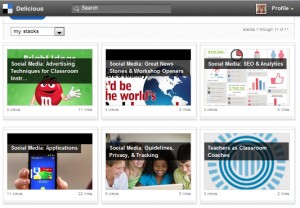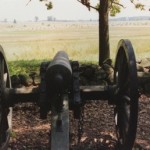Role-Play in the Classroom with Delicious

Delicious (del.icio.us) is an online social bookmarking platform that stores and categorizes photos, videos, and articles that teachers can use to motivate and engage students. It is part of social media because teachers can see each other’s folders called “stacks” of information and share each other’s postings of links on the web. These links are usually of high quality because teachers have invested time in surfing the internet to make meaningful selections.

Many teachers have used Delicious to share great links with other instructors. Today, we will explore how an instructor can allow her students to have access to this virtual file cabinet so that they can explore the materials at their own pace. The sharing of Delicious expands the delivery of basic content so students can watch selections on YouTube, read and capture a quote or an image on a blog’s Op-Ed piece, view pictures on Flickr, or refer to Wikipedia. What makes it worthy of classroom interaction?
It provides an opportunity for teachers to engage students in role-playing.
When coaching in schools, I encourage teachers to create engaging classroom experiences for their students. We’ve learned that as the rate of engagement increases, behavioral issues decrease. So, if we were in a coaching session now, I would pose the following question:
If our goal is to engage students in active learning, what role-playing experiences could we stage that would allow them to design, perform, or create something?
Here are some examples:
 Social Studies Content: Gettysburg
Social Studies Content: Gettysburg
Role: Museum Curator Selects a Video for the Entryway at a Museum
In Social Studies, you may ask students to vote on four different videos that describe the Battle of Gettysburg. They can refer to YouTube, read blogs posted by family members sharing recollections that were passed down over generations, view a map of the battle on Google images, or search Wikipedia for primary source documents.
Students would review everything posted to your Delicious stack to ultimately select the video most suitable for a museum exhibition. They will have had an opportunity to view the content from multiple perspectives, engage in discussions with their cooperative group members, and use higher-order thinking skills to make their final selection. Highly motivated students might surf the web to provide the class with additional choices. Thus, you are helping students move basic content from short-term memory to long-term memory through active learning.
 Language Arts Content: Wizard of Oz
Language Arts Content: Wizard of Oz
Role: Video Producer for the Anniversary of the Wizard of Oz
In Language Arts, you may have students select a specific theme from The Wizard of Oz to generate a 30-second commercial. Once you design your stack on Delicious, students can select a primary source document poster linked from Flickr; select a video from YouTube; highlight a specific scene that covers one of The Wizard of Oz themes (such as Identity, Conflict Resolution, Risk Taking, etc.); or read from an actor’s blog to learn what it was like to be an on the set. Of course, you may invite students to add to the stack through their own online research. Then, students can write a 30 second storyboard and videotape their performance, integrating some of the primary source documents, photographs, and quotes.
 Mathematics Content: Fractals
Mathematics Content: Fractals
Role: Photo Editor of a Book that Bridges Mathematics and Nature
In Mathematics, you can create a stack on Delicious with 15 different photographs of fractals (an “irregular” pattern within a pattern, within a pattern) in nature, such as ferns and broccoli. Students can add to that collection with as many as 30 choices by searching websites, blogs, and other online resources including The New York Botanical Garden. From there, each cooperative group or pair of students analyzes and selects an image. Students then write descriptions for each of the pictorial images and you will then create a not-for-sale classroom book that will be produced by an online-service. You could sell it if you gained the rights to reproduce each of the pictures.
 Music Content: Choral Parts
Music Content: Choral Parts
Role: Choral Director Teaching Professional Group Amplification or Reduction of Tone
In music, students learn how to be part of a section that functions within a larger whole. Each section, (i.e. soprano, alto, baritone) has to learn that at different times during the performance of a choral piece, they must either amplify or reduce the volume of their group. You create a stack on Delicious with different YouTube or sheet music samples of choral piece sections which exemplify this process. Each cooperative group would then select one of the samples and prepare a presentation demonstrating how the amplification or reduction of a specific part helped to create a mood or tone.
Regardless of the subject matter being taught, students should assess one another after all of the groups have completed their presentations. The class can vote on which groups deserve a “5-star status” in recognition of their exceptional work. I prefer this strategy to recognizing first/second/third place winners as it encourages all groups to be top winners!
© 2012 Andi Stix, Ed.D.
![]() In what ways have you used Delicious.com to actively engage your students? In what ways can you use your existing account and rethink it for active learning?
In what ways have you used Delicious.com to actively engage your students? In what ways can you use your existing account and rethink it for active learning?
Andi Stix is an educational consultant & coach who specializes in differentiation, interactive learning, writing across the curriculum, classroom coaching, and gifted education. For further information on her specialties or social media, please email her on the Contact page.
Click here to receive a PDF version of this article.





